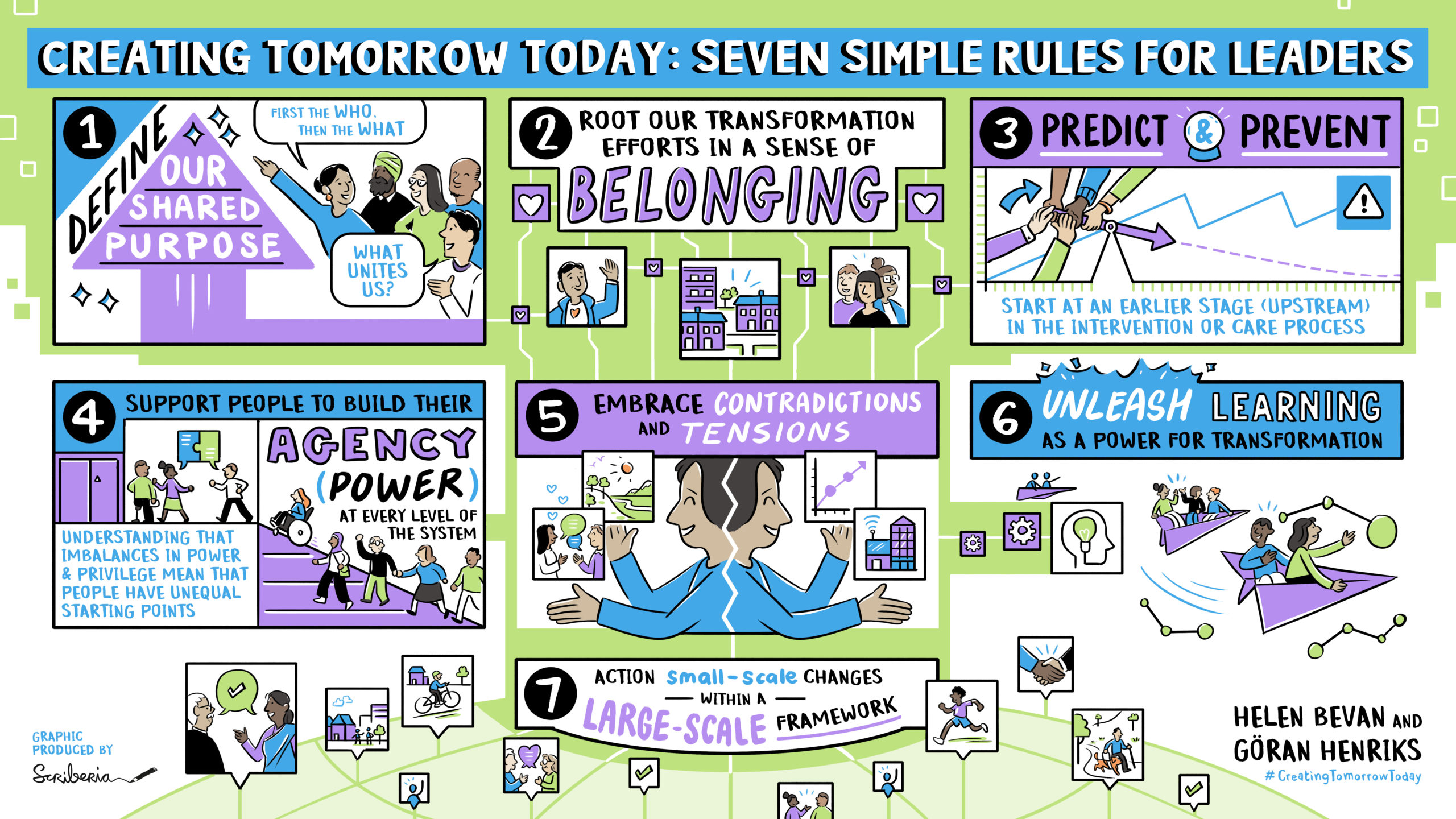This is the first of eight blogs that we will be posting on BMJ Leader over the coming weeks.
We both lead change inside our respective health and care systems; Helen in the National Health Service in England and Goran in Region Jönköping County in Sweden. Together we have 70 years’ experience in leading change in health and care. As well as working on our own countries, we have supported leaders across six continents seeking to make large scale change happen. The two of us have been working together for several years to combine our knowledge and experience. The COVID-19 pandemic and the desire to create different, better systems for the future has been an added motivation for us to share our perspectives. As a result, we have created a set of “seven simple rules” for leaders who are ambitious for transformation, based on our joint learning.

In this first blog, we will describe the motivation behind our simple rules. Over the next seven blogs, we will describe each of the rules in turn.
Rules for transformation in the context of the pandemic
Across the globe, we have seen more change occurring in the ways we deliver health and care as a response to the pandemic than we have ever seen before. Methods of delivery that we took for granted as the norm have been swept away in the COVID-19 response as people have responded in extraordinary ways.
Yet looking back over the last 30 years, the speed and complexity of change has been increasing all that time. To a large extent, COVID-19 has amplified what was happening already. To quote John Kotter: “The speed and complexity of change over the last 30 or 40 years have continued to go up with occasional spikes, like in March of 2020. There’s no evidence whatsoever that there’s going to be a post-COVID slowdown”
So, when we think about transforming the health and care system, we need to learn greatly from what has happened in the past year AND we need to think beyond that. This is not about a pre or post-COVID world; it’s about a world that was already moving fast, got faster as a result of COVID-19 and will continue at speed. The more we mobilise people around the potential for a radically different future, the better we prepare for the future.
Why “Simple rules”?
“Simple rules” is a principle from complexity science for transforming mindsets that drive behaviours and actions in large complex systems.
If we want to get a very large group of people, in a complex adaptive system to behave differently, with everyone moving in a coherent direction, there are at least two approaches we can follow.


Our thinking behind the simple rules is that rather than, or as well as, identifying sets of standards and policies that those in the system should comply to (approach #1), we seek to identify a few simple rules so that everyone understands why and what we are doing (approach #2). One of our simple rules, which we will discuss in blog 6, is “embrace contradictions and tensions”. There is a paradox between approach #1 and approach #2 and neither is likely to be the full answer. History shows that it is very difficult to create large scale, sustainable change through approach #1 on its own. On the other hand, we need formal leaders of the system to embrace different ways of working, such as approach #2, so we have to get senior leaders behind our simple rules. We have to work with both approaches, often in contradiction to each other, at the same time.
People often think that “rules” are about stopping people doing things. However, in our approach #2 context, changing the rules means rethinking and reshaping the conditions that characterise the dominant patterns of our system.
Where we have effective simple rules, everyone in the system understands them and delivers them in their own way. We are NOT saying: “this is how you should do it” or “do whatever you like”. We ARE saying: “these are the ways we want to work– express yourself using those elements”. Our goal with the simple rules is not to exercise control but to establish the high-level principles within which we all operate.
Here is an example set of simple rules to demonstrate this principle. Don Berwick published a collection of his speeches in the book Escape Fire: designs for the future of healthcare. In the foreword, Frank Davidoff synthesised the content into a set of eight simple rules that people who are improving health and care should follow. He is saying that if you want change to happen, rather than imposing top-down policies and asking people to comply with methods or procedures, get everyone following these basic principles:
| An example of simple rules
8 principles for designing the future of health care 1. Name the problem 2. Build on successes 3. Take leaps of faith 4. Look outside medicine 5. Set aims and show constancy of purpose 6. Understand systems 7. Make action lists 8. Never, ever lose sight of the patient as the central figure Source: Frank Davidoff: summarising the underlying in principles in the book Escape Fire by Don Berwick, 1992-2002 |
We have created our own set of simple rules for leaders of health and care who seek transformation that will result in improvements for large numbers of people.
| Creating tomorrow today: seven simple rules for leaders
1. Define our shared purpose 2. Root our transformation in a sense of belonging 3. Predict and prevent 4. Support people to build their agency (power) at every level of the system 5. Embrace contradictions and tensions 6. Unleash learning as a transformational power 7. Action small-scale change in a large scale framework Source: Helen Bevan and Goran Henriks |
Our rules are different (but complementary) to the Berwick rules. The Berwick rules apply to everyone who is working to make improvements at any level. Our rules are principles for leaders of large-scale system change who want to bring together people from across the system to build collective power and co-produce improvements.
Hundreds of people have worked with us to identify and develop these principles since we started this quest to create some simple rules in 2013. In the past few months, we have tested the relevance of our simple rules for a post-COVID world with system leaders from several countries.
The simple rules take us back to the very essence of health and care services. They remind us of what we are aiming to achieve in all our interactions with the care system. By operating through new leadership rules, we can create tomorrow today. Over the next seven blogs, we will outline each of the seven rules and make connections between the rules. We invite fellow leaders to dig into, reflect or apply these rules into their daily work.
At the end of every blog, we will add three questions for reflection. You may want to think about these yourself or ask other people in your team or network to read the blog and discuss the questions together.
Key questions to reflect on in blog one:
- Which of the seven simple rules “speak” to you the most at this early stage?
- How can the principle of simple rules support you in your wider transformation efforts?
- To what extent are you thinking about learning from the period before the pandemic (as well as the pandemic itself) in planning your transformation efforts post-pandemic?
Please join in the conversation on Twitter, adding #CreatingTomorrowToday and @BMJLeader to your tweets.

Helen Bevan @HelenBevan is Chief Transformation Officer with the NHS Horizons team, England.

Göran Henriks @GoranHenriks is Chief Executive of Learning and Innovation with Region Jönköping County, Sweden.
Declaration of interests
We have read and understood the BMJ Group policy on declaration of interests and declare the following interests: none.